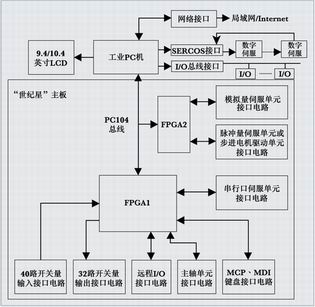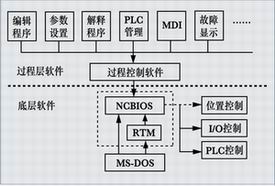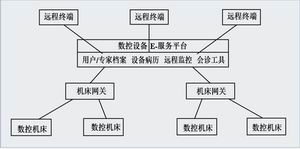Figure 2 HNC-21/22 open, networked CNC device hardware platform The HNC-21/22 CNC system hardware platform is based on the PC architecture, as shown in Figure 2. The system uses digital, pulse, analog standard interface or field bus to connect various functional components. The system and the external network are connected. It can be integrated with CAD/CAM, FMC/FMS and enterprise intranet to realize the network of CNC system. Turn. HNC-21/22 CNC system makes full use of the powerful features of the interface of industrial PC, using 10.4/9.4 inch true color TFT LCD screen, 8MB Flash ROM (expandable to 72MB) program power off storage, 16MB RAM (expandable Up to 64MB) processing buffer, equipped with hard disk and floppy disk, can load and store a large number of processing programs, with huge program processing capability, without DNC, can directly process up to 100MB G code program, using Ethernet, RS232 and other interfaces, easily Realize machine networking. The switch interface circuit of HNC-21/22, MCP, MDI keyboard interface circuit, feed axis interface circuit and spindle interface circuit are all integrated on a "Century Star" motherboard. The core device is ACTEL's FPGA chip. In order to meet the openness requirements of CNC devices, the "Century Star" motherboard adopts dual FPGA design. An FPGA chip is responsible for controlling the switching interface circuit, MCP, MDI keyboard interface circuit, spindle interface circuit, serial port servo drive interface circuit; another FPGA chip is responsible for controlling the pulse amount servo drive device or the stepper motor drive device interface circuit. Analog servo drive interface circuit. Two FPGA chips are controlled by Advantech Industrial PC through the PC104 bus. Utilizing the flexibility of the FPGA chip, by changing the firmware of the FPGA chip and flexibly matching the two FPGA chips without changing the hardware circuit, the following HNC-21/22 "Century Star" series CNC devices are constructed to maximize Reduce costs and improve performance. HNC-21/22A: can be equipped with 4 analog servo drives; Figure 3 Software platform of the HNC-21/22 CNC unit The software structure of HNC open and networked CNC system software platform HNC-21/22 CNC device is shown in Figure 3. The part above the dotted line is called application layer software (process layer software), which includes editing modules, parameter settings, decoding programs, PLC management, MDI, fault display and other functional modules related to user operations. For different numerical control devices, the difference in function is at this level, or the function increase and decrease are carried out at this layer. Each functional module can exchange information with the bottom layer through NCBIOS, so that the functional modules of this layer The hardware of the system is irrelevant. For different control objects (such as machining centers, milling machines, lathes, grinding machines, etc.), or different servo drives for the same control object, the hardware configuration of the CNC device may be different. In this case, just select the appropriate driver. These hardware modules can be driven without changing the underlying software and application layer software, showing good openness. When configuring the system, all the used boards must be described in NCBIOS.CFG (similar to DOS Config file) in the NCBIOS. The format is DEVICE=board driver name (the file name is usually .DRV, for example The driver for the HC4103 is HC4103.DRV). According to the preset setting of NCBIOS.CFG, NCBIOS transfers the driver of the corresponding board and establishes the corresponding interface pipe. Using unified hardware platform technology, in addition to DOS-based development and industrialization of the above-mentioned highly reliable and mature open CNC system software platform, it also developed an open architecture CNC system software platform based on LINUX. Its main technical features are: Based on LINUX free software platform Software CNC can use industry standard PC hardware or RISC processor, increase the open 32-bit architecture, break the 640k memory limit, powerful network communication function, excellent development environment, rich software resources In addition, Beijing University of Aeronautics and Astronautics developed the open architecture CNC system software platform based on Windows using the above hardware platform technology. Network Application of HNC-21/22 Open CNC System HNC-21/22 open, networked CNC system provides network interface with LAN or Internet connection. Through network interconnection, network resource sharing, remote control, monitoring and diagnosis can be realized. It has been applied in actual production and obtained. A satisfactory result. Figure 4 Networked workshop of a factory When Huazhong CNC carried out the copy milling CNC transformation in a factory, it realized the networked interconnection of two machining centers, two copy milling and gantry milling in the mold shop, as shown in Figure 4. By sharing the copy data through the network, the ordinary CNC milling machine can also process the profiling parts, improve the profiling efficiency, and save the cost of expensive copy milling equipment. At the same time, the factory CNC machine tool network is connected with the office network. The office CAD/CAM system can exchange information and control with CNC machine tools conveniently and quickly. It can be designed and programmed remotely and then transmitted and shared through the INTERNET network. The part processing program realizes the network integration of CAD/CAM/CNC, which greatly improves the production efficiency and the utilization rate of the equipment. Currently, these devices are in good operating condition and have significant economic benefits. Fundamental Through the Internet, the CNC equipment, field equipment maintenance engineers, equipment manufacturing enterprise maintenance engineers and domain experts distributed in different regions are organized and linked to realize rapid information transmission between equipment and people and between people to form a network. The CNC equipment diagnostic and maintenance consulting system and video conferencing system use the fast and modern communication means of the network to quickly diagnose the fault of the numerical control equipment. Figure 5 Overall structure of the numerical control equipment E-service system System composition and workflow The overall structure of the numerical control equipment E-service system is shown in Figure 5. It consists mainly of three parts: numerical control equipment E-service platform, CNC machine tool gateway and remote user terminal. CNC equipment E-service platform is a special website built on the Internet, including user files of CNC equipment manufacturing enterprises, domain expert files to assist in equipment fault diagnosis, electronic medical records of user equipment, remote operation of equipment, diagnosis and maintenance module. , as well as online consultation tools. The role of the platform is to organize equipment diagnostic information, user information, and expert information related to equipment technical support and services through a flexible and convenient form of the Web to form a networked equipment fault diagnosis and service guarantee system, and improve product after-sales service. Quality of service and efficiency. The machine tool gateway is a CNC machine tool connector consisting of a PC or laptop running at the production site. One end is connected to the E-service platform of the numerical control equipment through the telephone network, mobile communication network and the Internet, and the other end is connected via LAN/RS232. The form is connected to a CNC machine. Its function is to send PLC information and external audio, video information and sensor information inside the CNC machine to the Internet for remote diagnosis and use. In addition, it can also forward the control information sent by the remote terminal user's browser to the CNC machine connected to it. The remote terminal can be any computer on the Internet, and its users are equipment use engineers, equipment manufacturing engineers, or domain experts. They obtain and publish information from the numerical control equipment E-service platform through a browser running on the remote terminal, and perform remote collaborative diagnosis of the numerical control equipment failure to provide remote technical support. Figure 6 Schematic diagram of the working process of the numerical control equipment E-service system The typical working process of the numerical control equipment E-service system is shown in Fig. 6. When enterprise users encounter technical problems, they first log in to the CNC equipment E-service platform, and use the typical cases provided by the platform, equipment common faults, CNC equipment diagnostic expert system and other tools to try to solve the problem themselves; if the user can not solve the problem under the tools provided by the platform Then request the equipment manufacturing enterprise engineer as the platform administrator to help solve the problem; if the problem still cannot be solved, the platform administrator asks the experts in the field to conduct the joint consultation until the problem is solved. Linear light is a type of Pendant Light that is primarily made of lines and is usually made of materials such as metal, wood, or plastic. The design of the linear light is simple and modern, suitable for various interior decoration styles, especially for modern minimalist style homes. The shape of the linear light is diverse, it can be straight, curved, or a combination of multiple lines to form a complex shape. The light of the linear light is soft and uniform, suitable for lighting in places such as living rooms, dining rooms, and study rooms. Linear Pendant Light,Flush Linear Light Fixture,Linear Light Fixture For Dining Room,Linear Light Ceiling Zhengdong Lighting Co., Ltd. , https://www.sundintlighting.com
The first layer: configurable features, open human machine interface and communication interface and protocol.
The second layer: The control device allows replacement and addition of specific modules in the NC core to meet the special requirements of the user under a clearly fixed topology.
The third layer: a "fully open" control device with a completely variable topology. (current standard is not defined)
HNC open, networked CNC system hardware platform HNC-21/22 CNC system platform design ideas are:
Support for ONC Layer 1 and Layer 2 requires retention of the next layer of support system from economy to high-end scalability and reduction through application interface to develop various applications to form different products through device drivers to connect various CNC Component PC architecture to run PC applications 
HNC-21/22C: can be equipped with 4 serial port servo drives;
HNC-21/22D: can be equipped with 4 pulse servo drives or stepper motor drives;
HNC-21/22F: It can be equipped with 4 pulse servo drives or stepper motor drives or 4 analog servo drives or 4 serial port servo drives. 
The part below the dotted line in the figure is called the underlying software. It is the software platform of the HNC-21/22 CNC device. The RTM module is a self-developed real-time multitasking management module responsible for task management and scheduling of the CNC device. The NCBIOS module is the basic input/output system of the CNC device and manages all external control objects of the CNC device, including device driver management, position control, PLC control, interpolation calculation and internal monitoring. NCBIOS forms the NC commonality part of the NC kernel, provides standard interface functions, and is open to users, adapting to user's individual requirements, and is conducive to variety derivation and secondary development.
It is precisely because of the good openness of HNC open and networked CNC system platform that the National CNC System Engineering Technology Research Center and Huazhong CNC have developed a general-purpose CNC system such as car and milling in just a few years. It also derives various CNC systems such as gear processing machines, profiling machines, grinding machines, forging and stamping machines, quilting machines, combination machine tools, planers, pipe bending machines, glass processing machines, etc., and industrialization. 
Huazhong CNC remote operation monitoring and diagnosis platform 

Under the support of the National 15th Research Project, 863, National Natural Science Foundation and other related projects, the networked and open CNC system platform jointly developed by the National CNC System Engineering Technology Research Center and Huazhong CNC complies with the ONC standard and has good openness and Powerful network function, has derived more than 30 cars, milling, machining centers, gear processing machines, profiling machines, grinding machines, forging and stamping machines, quilting machines, combination machine tools, planers, pipe bending machines, glass processing machines, etc. The numerical control system has been strongly verified in practical applications.
Research Status of a New Generation of Open and Networked CNC Systems (II)
The open level of the ONC open CNC system is reflected in: